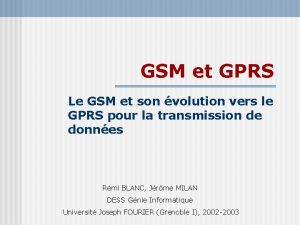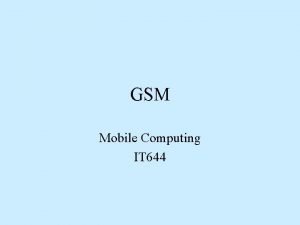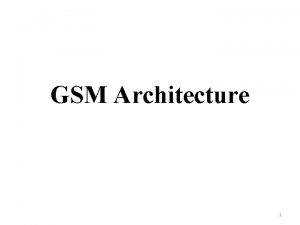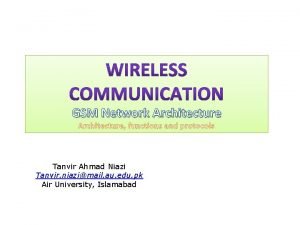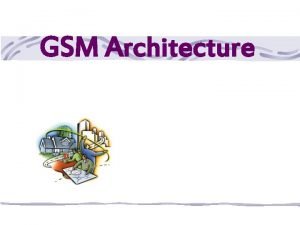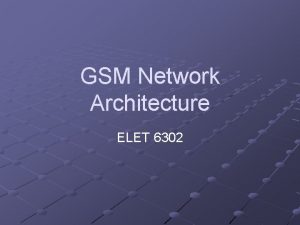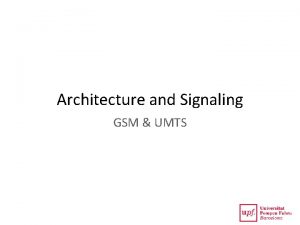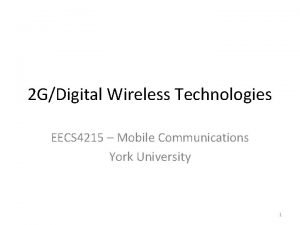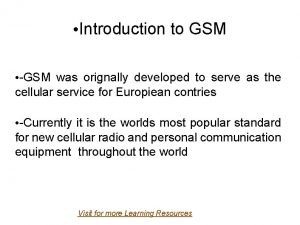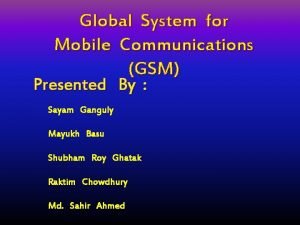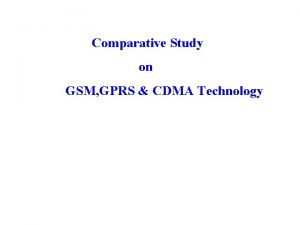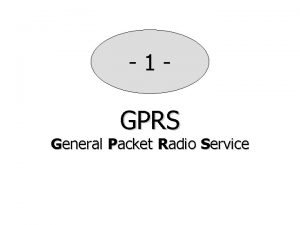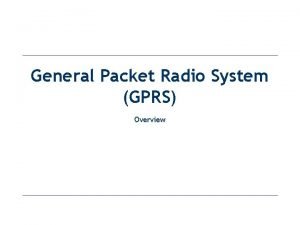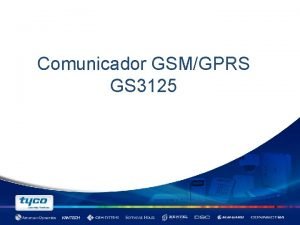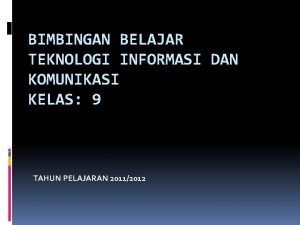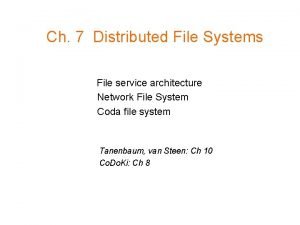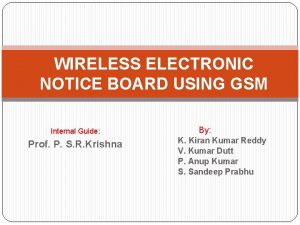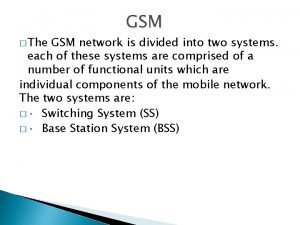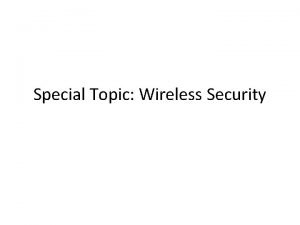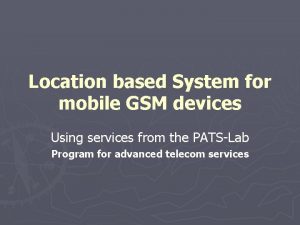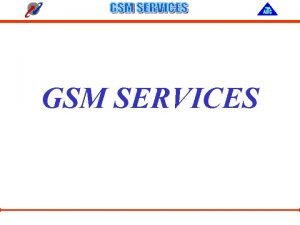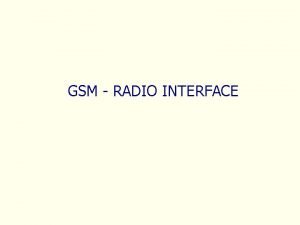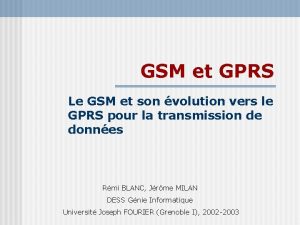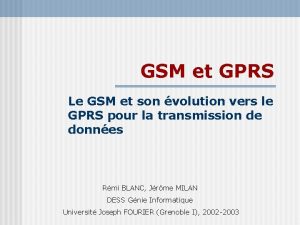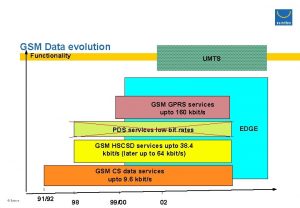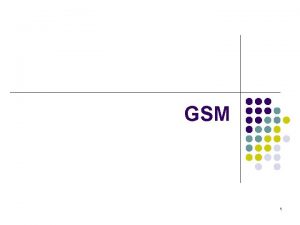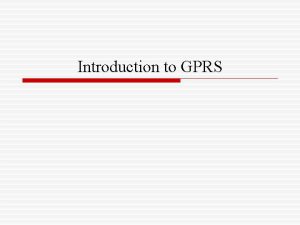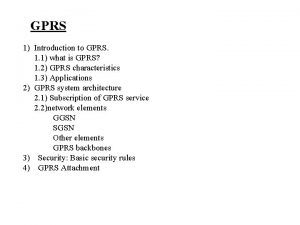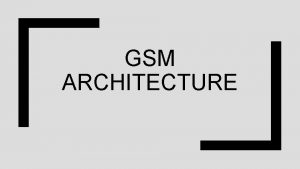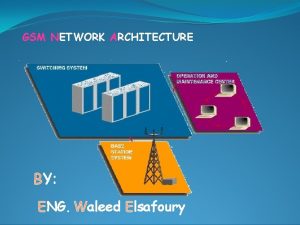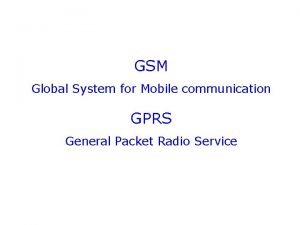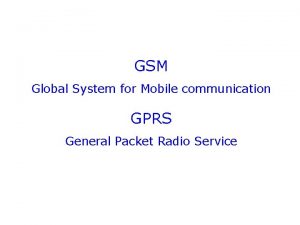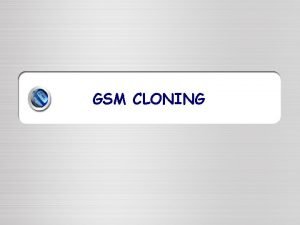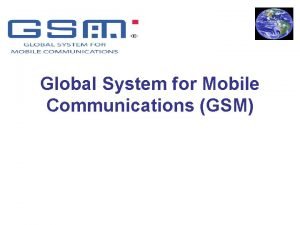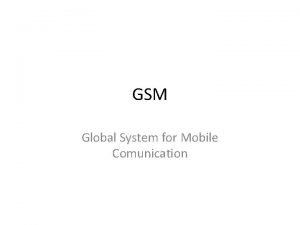GPRS 20101029 Outline Introduction GSM system architecture GPRS





































- Slides: 37

GPRS 蔡佩倪 2010/10/29

Outline Introduction GSM system architecture GPRS network architecture GPRS/GSM mobile classes GPRS attach procedure PDP context activation GPRS Protocol Stack GPRS channels Summary 2

Introduction The General Packet Radio Service (GPRS) is an European Telecommunications Standard Institute (ETSI) standard for packet data transmission using the core GSM (Global System for Mobile Communications) radio access network. It provides switched packet data transfer to efficiently utilize the radio resources. It provides a quick session set up and fast data transmission speeds. Supports immediacy (no dialup connection is necessary) theoretically supports maximum speeds of up to 171. 2 kbps 3

GSM System Architecture - I VLR MSC E BSS BTS MS BSC A bis A G C OMC Um B D VLR B MSC D HLR C AUC F other GSM PLMN 與固定網路間之介面 PSTN PSDN EIR ISDN 4




GPRS network architecture 8

GPRS network architecture The gateway GPRS support node (GGSN) provides a gateway between the GPRS network and the public packet data network (PDN) or other GPRS networks. provides authentication and location management functions, connects to the home location register (HLR) by means of the Gc interface, and counts the number of packets transmitted for accurate subscriber billing. 9

GPRS network architecture The serving GPRS support node (SGSN) controls the connection between the network and the mobile station (MS). provides session management and GPRS mobility management functions such as handovers and paging. It also counts the number of packets routed. 10

GPRS network architecture Functions of the packet control unit (PCU) converting packet data into a format that can be transferred over the air interface managing radio resources implementing quality of service (Qo. S) measurements 11

GPRS/GSM mobile classes Class A (GSM/GPRS) Class A mobiles can attach to the GPRS and GSM network simultaneously. Class B (GSM/GPRS) This class is similar to class A with the exception that Class B mobile phones will not support simultaneous traffic. Most GPRS mobile devices are Class B. Class C (GSM or GPRS) This class of mobile phones will have both GSM and GPRS functionality but will attach to only one network at a time. 12

GPRS Routing Example 1 13

GPRS Routing Example 2 14

GPRS Routing Example 3 15

The GPRS attach procedure A GPRS attach is a GPRS mobility management (GMM) process that is always initiated by the mobile phone. Depending on the settings of the mobile phone, the GPRS attach may be performed every time the phone is powered on, or it may be initiated manually by the user. 16

The GPRS attach procedure 17

PDP context activation A PDP context activates a packet communication session with the SGSN. During the activation procedure, the mobile phone either provides a static IP address or requests a temporary one from the network. It also specifies the access point name (APN) with which it wants to communicate. The mobile requests a desired quality of service (Qo. S) and a network service access point identifier (NSAPI). 18

PDP context activation 19

GPRS Protocol Stack 20

Transmitting the packet data units 21

GPRS logical channels Logical channels are pre-defined functions supported by frames within a physical channel. GPRS physical channels generally carry two types of information: control signaling for establishing and maintaining a GPRS service, and user data traffic. GPRS logical channels can be classified as packet control channels and packet traffic channels. 22

GPRS logical channels 23

GPRS logical channels PBCCH (packet broadcast control channel) is used to broadcast packet data system information to all GPRS mobiles in a cell. The PBCCH might not be present for certain channel combinations, in which case the BCCH will be used to broadcast packet system information. 24

GPRS logical channels PCCCH (packet common control channel) a set of logical channels used for common signaling between the mobile station and the base station. (PRACH, PPCH, PAGCH, PNCH) PRACH (packet random access channel) �is used only in uplink to initiate uplink transfer. PPCH (Packet Paging Channel) �is used to page a mobile prior to downlink packet transfer. 25

GPRS logical channels PAGCH (packet access grant channel) �is used in the packet transfer establishment phase to send resource assignment messages to a mobile prior to packet transfer. PNCH (packet notification channel) �is used to send a point-to-multipoint multicast notification to a group of mobiles prior to point-tomultipoint multicast packet transfer. 26

GPRS logical channels PTCH (packet traffic channel) PDTCH (packet data traffic channel) �is allocated for data transfer. �It is dedicated temporarily to one or a group of mobiles for multicast applications. PACCH (packet associated control channel) �is used to convey signaling information related to a given mobile PTCCH (packet timing advance control channel) 27

GPRS physical channels Radio channels of GPRS are the same as GSM TDMA frame = 4. 615 ms Timeslot 1 2 3 4 5 6 7 8 Ch 1 Ch 2 Ch 3 Ch 4 Ch 5 Ch 6 Ch 7 Ch 8 Frequency 2 Ch 1 Ch 2 Ch 3 Ch 4 Ch 5 Ch 6 Ch 7 Ch 8 Frequency 124 Ch 1 Ch 2 Ch 3 Ch 4 Ch 6 Ch 7 Ch 8 …… …… Frequency 1 Ch 5 28

GPRS physical channels The physical channel dedicated to packet data traffic is called a packet data channel (PDCH). The logical channels are mapped over physical channels using the technique of “multiframing. ” The GPRS multiframe length is 52 TDMA frames, and it is organized into 12 blocks of 4 consecutive TDMA frames, plus 4 idle frames. 29

The 52 -multiframe structure 30

52 -multiframe for four time slots 31

Mapping logical channels to physical channels 32

Mapping logical channels to physical channels Example on downlink PBCCH PAGCH PDTCH PACCH PPCH PBCCH PAGCH PDTCH PACCH PPCH B 0 B 1 B 2 B 3 B 4 B 5 B 6 B 7 B 8 B 9 B 10 B 11 PRACH PDTCH PACCH B 8 B 9 B 10 B 11 Example on uplink PRACH B 0 B 1 PRACH PDTCH PACCH B 2 PRACH PDTCH PACCH PRACH PDTCH PACCH B 3 B 4 B 5 B 6 B 7 33

Resource allocation TS 0 TS 1 TS 2 TS 3 TS 4 GSM only TS 0 TS 1 TS 2 GSM only TS 5 TS 6 TS 7 GPRS only TS 3 TS 4 TS 5 GSM & GPRS TS 6 TS 7 GPRS only 34

Summary GPRS technology adds packet-switching capability to GSM PCU, GGSN, SGSN Time slot, frame 1 TDMA frame = 8 Time slot 52 -multiframe structure 12 Radio blocks 35

References Agilent Understanding General Packet Radio Service (GPRS) http: //cp. literature. agilent. com/litweb/pdf/5988 -2598 EN. pdf S. Emmanuel, S. Patrick, P. Pierre-Jean, GPRS for Mobile Internet, Artech House, 2003. Kai-Wei Ke, Chen-Nien Tsai, and Ho-Ting Wu, “Performance analysis for hierarchical resource allocation in multiplexed mobile packet data networks, ” Computer Networks, Vol. 54, Issue 10, 2010, pp. 1707 -1725. General Packet Radio Service (GPRS) Overview http: //www. pcs. csie. ntu. edu. tw/course/pcs/2007/reference/08_GPRS_Overv iew. pdf 廖宏祥,鐘嘉德。整合分封無線服務(GPRS)簡介。暨大電子雜誌。 http: //beaver. dlc. ncnu. edu. tw/projects/emag/show. aspx? data. Id=98 d 2571 b 481 d-483 b-8804 -f 64 ed 720 c 38 b 邱弘斌。行動網際網路技術與應用上課投影片。 36

THANK YOU Q&A 37
 Architecture du gprs
Architecture du gprs Normal burst in gsm
Normal burst in gsm Mobile switching center architecture
Mobile switching center architecture Gprs architecture
Gprs architecture Private apn architecture
Private apn architecture Gprs architecture
Gprs architecture Gsm network infrastructure
Gsm network infrastructure Gsm network structure
Gsm network structure Gsm protocol architecture
Gsm protocol architecture Mobile station (ms)
Mobile station (ms) Gsm network architecture
Gsm network architecture Lac cell id
Lac cell id Eecs 4215
Eecs 4215 Facch in gsm
Facch in gsm Gsm pbx system
Gsm pbx system Global system for mobile communications
Global system for mobile communications Sandwich in a sentence
Sandwich in a sentence Gprs cdma
Gprs cdma Gprs
Gprs Gsm protocol
Gsm protocol Dls iv software download
Dls iv software download Kepanjangan dari gprs adalah.... *
Kepanjangan dari gprs adalah.... * Gprs stands for
Gprs stands for Sgsn stands for
Sgsn stands for System architecture diagram for hospital management system
System architecture diagram for hospital management system File service architecture in distributed system
File service architecture in distributed system Introduction paragraph outline
Introduction paragraph outline 5 paragraph essay outline
5 paragraph essay outline Introduction to software engineering course outline
Introduction to software engineering course outline Wireless electronic notice board using gsm
Wireless electronic notice board using gsm Gsm network
Gsm network Twn gsm
Twn gsm Secure gsm
Secure gsm Gsm location based solution
Gsm location based solution Gsm um interface
Gsm um interface Gsm services and features
Gsm services and features Gsm radio interface
Gsm radio interface Gsm network structure
Gsm network structure
